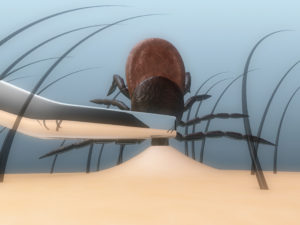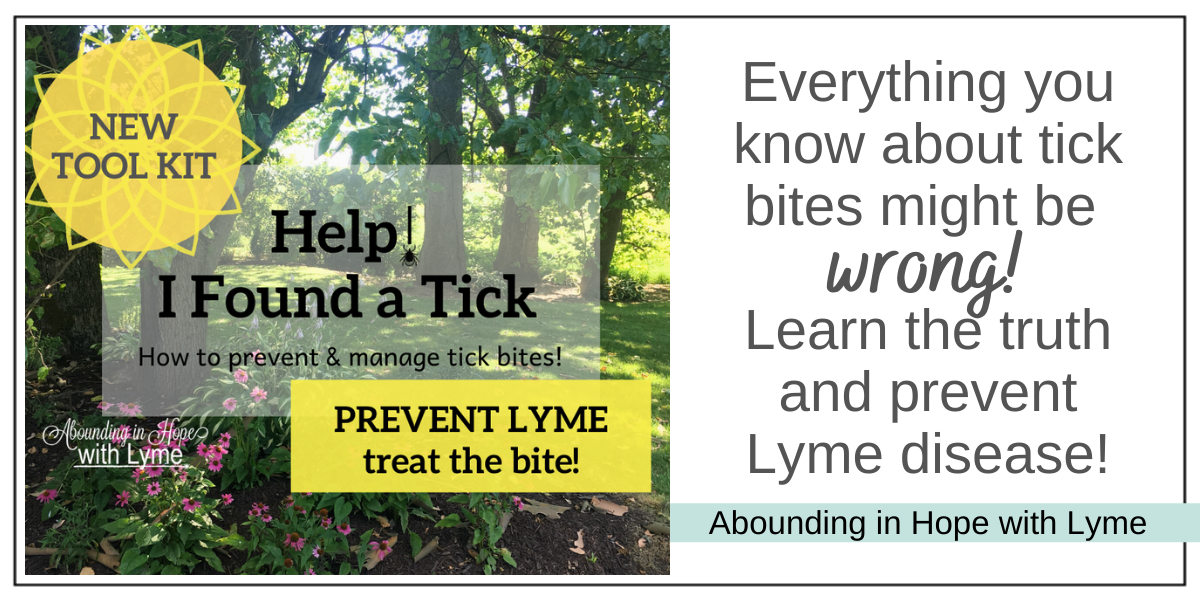It’s always frightening to find a tick attached to you or your child and it’s very important to know what to do in order to protect yourself from one of many detrimental tick-borne infections.
My family’s physicians followed the CDC’s guidelines regarding diagnosis and treatment for Lyme Disease and because of this, our illnesses went undiagnosed for years resulting in unnecessary suffering from chronic tick-borne diseases. We have also had to spend hundreds of thousands of dollars out of pocket for treatment. This is the reason for my blog. I want others to be aware and educated so that no one has to suffer from this disease.
Disclaimer: I am not a doctor and what I have stated here is only my opinion based on my research. Seek out a knowledgeable Physician who can better help you.
[Please note: I have updated this post to reflect more natural treatment options. As I continue to research and hear from other Lyme sufferers I have come to believe that antibiotics may not always be the best first approach. My family and I have experience with antibiotics, herbs, and homeopathy.]
You can avoid chronic tick-borne illness if you know what to do and how to protect yourself. I wrote about this in 10 Ways To Protect Yourself From Lyme

Now, let’s go over what you should do if you do find a tick.
IF YOU FIND A TICK
1. Don’t panic. I know what it’s like when you find that nasty little bug attached. Your immediate response is to scratch it off or remove it as fast as you can, but if you panic you could increase your risk of infection. Be very careful while removing the tick so you don’t leave the head attached to you. If the tick is embedded go to your doctor or to the ER as soon as possible and allow them to remove it.
2. Use a pair of sharp tweezers. Using tweezers, place them over the tick’s head and as close to the skin as possible, pull the tick straight out. NEVER smother the tick, if you do it will immediately inject all of its gut contents into you. Lyme Prevention

3. Store the tick. Put the tick in a small plastic or glass vial or in a plastic Ziploc bag. There’s no need to add alcohol or anything else just put it in a storage container by itself.
It’s far more accurate to have the tick tested for disease than to test people. There are many labs that will test your tick for various pathogens. The Bay Area Lyme Foundation offers free tick testing.
4. Disinfect. Clean the area with rubbing alcohol or another antibacterial cleaner.
5. Observe. Keep a close watch on the area where you were bitten but don’t wait to go to the doctor. Circle the area with a sharpie or pen and watch for any discoloration, swelling or rash. Also be aware of any fever or flu-like symptoms. Symptoms could appear soon after the bite or they could appear weeks or months later.
6. Treatment. Seek the advice of your physician as soon as possible but understand that most doctors follow CDC guidelines and that by following their advice you could end up with a chronic infection which could spread to every organ and affect every system of the body.
A Lyme infection can go chronic in as little as 4 weeks.
Here’s a printable chart I created based on the information provided by Dr. Ray Charles Jones. I recently included links to natural treatment options. Print this out and take to your doctor. Treat Tick Bites
I always recommend seeking out a physician who is knowledgeable in diagnosing and treating tick-borne infections. Sometimes this means finding an alternative or Naturopathic physician.
IMPORTANT TO KNOW
ILADS physicians are now recommending treatment for every tick bite. A longer treatment period with higher doses of antibiotics is recommended for any tick bite producing an EM rash or other symptoms. (Read the updated guidelines. ILADS Treatment Guidelines)
If you choose antibiotics, treatment could last for up to 6 weeks or longer which seems like a lot but really is not as significant as years of antibiotic treatment and out of pocket expenses for a chronic infection.
“Antibiotics mainly work by stopping bacteria from reproducing. Most bacteria reproduce every 20 minutes. Lyme replicate every 1 to 16 days. A sinus infection is treated within 14 days. It would take 18 months to have the same effect to kill Lyme.” The Lyme Solution, Darin Ingels, N.D.
There are many natural ways to prevent tick-borne infections. Some use herbal medicines like using Astragalus and Cats Claw, see www.BuhnerHealingLyme.com. Banderol and Samento have been shown to be effective when used together. Others have used homeopathic remedies, such as Ledum, with great success.
Natural treatments are an option which will allow your immune system to stay strong which is important for helping the body to fight these infections. Antibiotics are not always the best option to completely cure an early infection because no one really knows how long you need to take them and many times doctors will not prescribe doses high enough or for long enough duration. Antibiotics can also cause secondary issues like Candida or other side effects.
It’s important to know:
- Symptoms do not always appear immediately after infection. Many times symptoms appear gradually over a period of weeks, months or even years.
- The classic bulls-eye rash appears in approximately 25% of people who are infected with Lyme bacteria. Other rashes are common but not always present.
- Ticks also carry and transmit many other pathogens such as Bartonella, Babesia, Ehrlichia, Mycoplasma, Rocky Mountain Spotted Fever, Epstein Barr Virus, worms, parasites, and viruses.
- It is important and helpful to identify the type of tick that you have.
Ticks can transmit infections in less than 24 hours.
[bctt tweet=”Ticks can transmit infections in less than 24 hours! #LymeAwareness” username=”aboundinginhope”]
Ticks of all types carry bacterial, parasitic and viral infections. By knowing which type of tick you can learn which infections they carry and be on the lookout for those particular symptoms. Keep in mind that research is showing a crossover of pathogens in ticks, meaning that Borrelia is now being found in ticks other than the black-legged tick.
FURTHER INFORMATION
The Importance of Proper Treatment
Lyme Disease, What It Is and Why You Should Care
Effectiveness of Banderol and Samento
Homeopathic Lyme Disease Evaluation and Treatment
Auricular and Homeopathic Treatment for Lyme Disease
TICK TESTING
Igenix Tick Tests
TickReport Tick Testing
Clongen Labs




Hi Lynna, I'm so sorry you found a tick on your 3yo. I really hate those little nasty things. Thank you so much for letting me know that my blog was helpful. <3
Tricia, we just found a tick on my 3-year-old and I immediately came to your site to be reminded of how to respond properly. I am so glad you've provided this information for others!